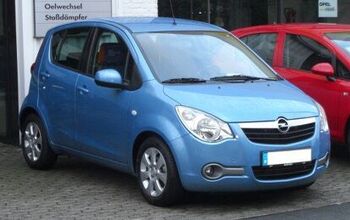The UAW: Cut and Run?
I wouldn’t join any union that would have me as a member. And yet the United Autoworker’s Union (UAW) wants me. Yep, UAW Local 1981 represents freelance writers. The pen-pushing Local is part of a growing trend within the UAW. As more and more of their members accept buyouts and early retirements, as the UAW [secretly] realizes that they’ve milked their Detroit cash cow to the point of death, the union is pulling a Studebaker. They’re diversifying out of their core business before their core business goes tango uniform.
The UAW was formed in 1935. In 1969, membership peaked at roughly 1.5m members. By 2002, 639k industry workers were paying UAW dues. By 2005, the number sank to 557K members. After the next round of “attrition plans” from GM, Ford, and Delphi, there’ll be fewer than a half million active UAW members left. The exodus occurs against a backdrop of a general decline in the “market” for union representation. According to the US Bureau of Labor Statistics, national union membership has dropped from 20.1% of the U.S. labor force in 1983, to 12.5% in 2005.
What’s worse, some union members are beginning to question the UAW’s efficacy. Speaking to The Detroit Free Press, one Ford employee opting for early retirement noted "it would be belaboring the obvious to say that the UAW's nuclear option of a strike is not as evident as it used to be." If members believe the UAW has “gone soft,” labor leaders negotiating next year’s contract will be between a rock (breakaway dissent, wildcat strikes and a potential fall from power) and a hard place (clinging to contracts that kill the golden goose). Bet on Plan B.
Like many other experts, labor law expert Jim Hendricks doesn’t see it that way. "I don't think they can survive the way they used to. Manufacturers and employers feared this union because of their sheer size and strength." Hendricks thinks the UAW should merge with other unions facing the same problems. While UAW leadership hasn't ruled out the possibility, they seem more interested in conquering new territory on their own.
In the short term, the UAW faces the same problem as The Big Two Point Five: they’ll soon have more retirees than active employees. Like any clued-in capitalist, the UAW’s management knows they have to grow to keep the cash flowing. Logically enough, the UAW has spread their recruitment efforts throughout the rest of the automotive industry, including auto parts and heavy truck manufacturers and auto dealerships (mechanics and back office staff).
At the same time, the UAW is scrambling to organize any group that’s not already represented by some other labor union (and edging into some areas which already are). So far they’ve established a presence in household appliances, brewing, lawn/garden equipment, tools and hardware, firearms, boats, modular housing, toys, musical instruments, pharmaceuticals, cosmetics, food processing, public radio stations, casinos, aerospace and defense.
The UAW has also cast their net over a wide range of professions: draftsmen, industrial designers, engineers, computer specialists, health care professionals, journalists and writers, curators and librarians, graduate teaching assistants and staff lawyers.
Most promisingly of all– given the taxpayer’s seemingly limitless purse and any union’s ability to use political muscle to wrest financial concessions– the UAW is organizing state and local government employees, such as social service workers. Their latest conquest: Michigan’s home-based child care providers. So far, the UAW reports it’s organized about some 40k care providers.
And yet the UAW claims they’re being selective about potential members. UAW Secretary-Treasurer Elizabeth Bunn stated, "We are not interested in representing workers where we don't feel we can act as a powerful voice for them." Translation? Unless you’re in an industry where the UAW has a chance of establishing a stronghold or getting a lot of (dues-paying) members, fuhgeddaboudit!
With the UAW dividing its attention amongst these diverse areas, how can they successfully address the labor issues of any of their smaller constituent groups? Can an organization where the leadership has focused on workers in one single industry for the past 70 years effectively advocate for other totally unrelated industries?
The needs and concerns of nurses and lawyers aren’t necessarily the same as those of assembly line workers, and you can’t take the same actions against government entities that you can against giant corporations. Is the UAW equipped to handle this diversity, or are they bloating their portfolio beyond any rational hope of quality, GM-style?
If successful, the UAW’s expansion is a major threat to domestic automakers. It will strengthen the only power that any negotiator ever possesses: the power to walk away. In fact, the more industries with UAW representation, the more the union needs to look tough. Autoworkers, indeed the entire domestic automobile industry, could be sacrificed on the altar of the union’s long term survival strategy.
More by Frank Williams
Latest Car Reviews
Read moreLatest Product Reviews
Read moreRecent Comments
- Hari Your route home sounds like the perfect stretch for a car like the Alfa Romeo Giulia. Its renowned handling and dynamic performance make it an ideal match for those curves. For enthusiasts or potential owners interested in understanding all the capabilities of the Giulia 2017, the owner’s manual is an invaluable resource. Check it out here: https://chatwithmanuals.com/automobiles/2017-alfa-romeo-giulia-owners-manual/. Our AI-powered chat makes navigating the manual simple, helping you quickly find specific details about the car's features and specs. Perfect for making the most out of those driving moments and truly understanding your vehicle!
- Dale I'd consider the RAV4 if the Prime were on the table as paying for gas is for suckers. Otherwise, we have a couple of Mazdas and they are swell. I've driven older versions of both and the CX-5 is a nicer place to live.
- Haran Spot-on review of the Mercedes-AMG GT’s price adjustments and new features! For those intrigued by the all-wheel drive and enhanced features of the latest model, you can delve deeper with the complete operator's manual available here: https://chatwithmanuals.com/automobiles/mercedes-amg-gt-operators-manual-edition-c2020/. It’s a fantastic resource for understanding all the specs and new additions without getting bogged down by the complexity typically associated with car manuals. Chat with the manual using AI to quickly find exactly what you need to know about this sporty beast. Perfect for those who appreciate detailed insights on their luxury investments!
- Flashindapan Beautiful color combinations. I assumed they stop selling the TT here at least five or six years ago.
- Carson D Just don't be the whistleblower who reports on the falsification of safety data. That's a deadly profession.


































Comments
Join the conversation
And I don't believe for one minute that the UAW is responsible for what has befallen the US auto industry. Like Henry Ford, I also believe that workers need to be paid a living wage so that they are able to buy the products they produce. But like skyrocketing CEO salaries, paying an employee $100,000 a year to push a broom (that's a metaphor) is equally unreasonable. The fact is that business in the US only reacts to crisis. The idea here has always been to get as much as I can and everyone else be damned, regardless of the consequences. Even if you were to implement drastic strategies that would make imports uncompetitive on price, history has shown us that all the domestic manufactures would do is raise their prices to just under what the imports sell at. That goes for all industries, not just automotive.
Government to the rescue...... http://www.lewrockwell.com/suprynowicz/suprynowicz55.html